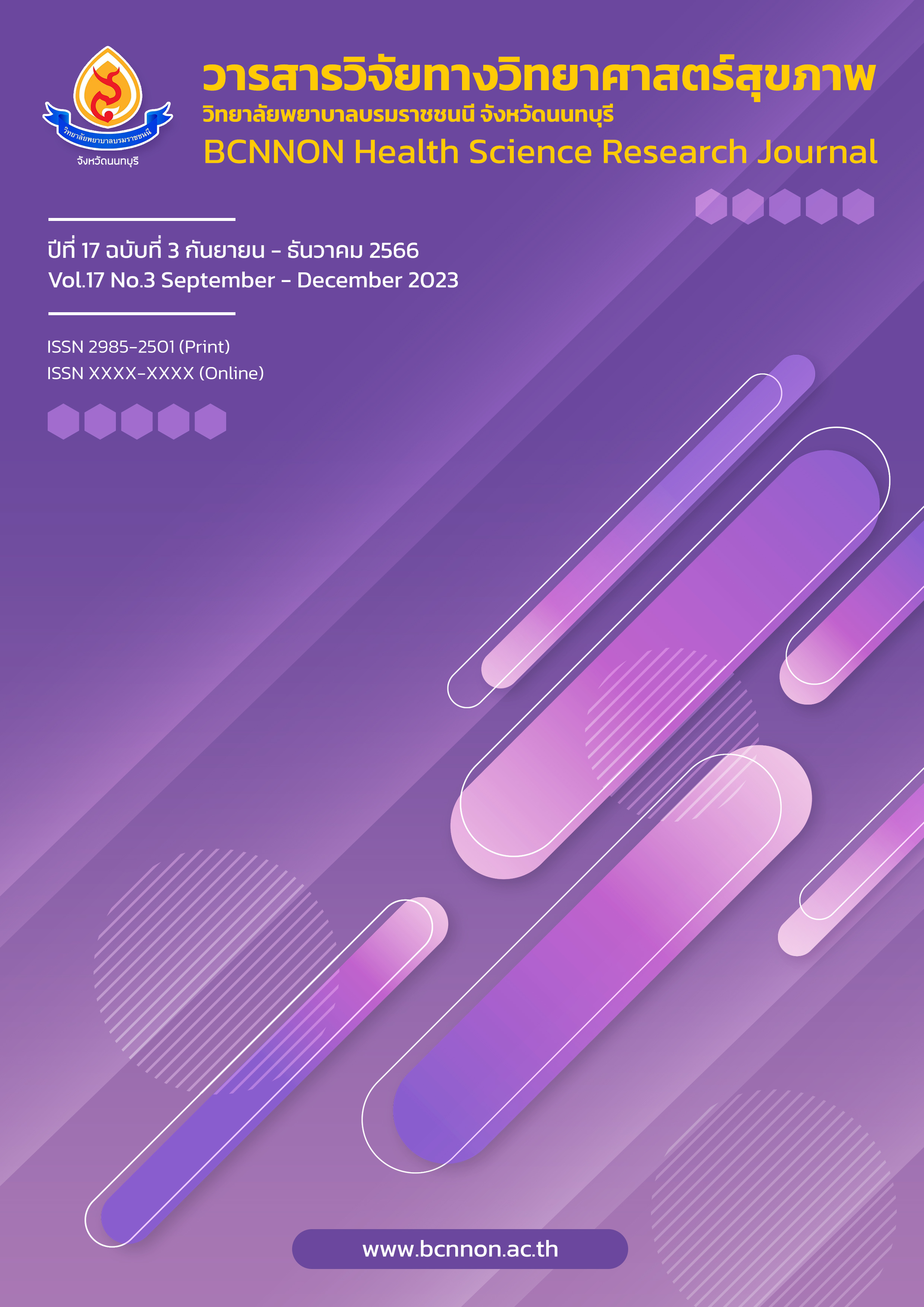การพัฒนาโปรแกรมเพิ่มพูนทักษะการสื่อสารด้วยไอเอสบาร์ (ISBAR) โดยวิธีสะท้อนคิด สำหรับนักศึกษาพยาบาลศาสตร์ ในรายวิชาปฏิบัติ การพยาบาลผู้ใหญ่และผู้สูงอายุ
Main Article Content
บทคัดย่อ
บทนำ : ทักษะการสื่อสารของนักศึกษาพยาบาล มีผลต่อความสามารถในการส่งต่อข้อมูลทางคลินิกของผู้ป่วย ไอเอสบาร์เป็นเครื่องมือที่จะนำไปสู่การพัฒนาทักษะการสื่อสารของนักศึกษาพยาบาล
วัตถุประสงค์การวิจัย : เพื่อศึกษาสภาพการณ์ พัฒนาและประเมินผลโปรแกรมเพิ่มพูนทักษะการสื่อสารด้วยไอเอสบาร์โดยวิธีสะท้อนคิด
วิธีการวิจัย : การวิจัยและพัฒนา 3 ระยะ คือ 1) ศึกษาสภาพการณ์ 2) พัฒนาและทดลองใช้โปรแกรมเพิ่มพูนทักษะการสื่อสารด้วยไอเอสบาร์โดยวิธีสะท้อนคิด 3) ประเมินผลโปรแกรมจากนักศึกษาพยาบาล กลุ่มทดลอง 32 คน กลุ่มควบคุม 32 คน พยาบาลพี่เลี้ยง 15 คน และผู้ป่วย 64 คน เก็บข้อมูลด้วยแบบประเมินความรู้และการปฏิบัติในการส่งเวร และแบบสอบถามความพึงพอใจ การใช้โปรแกรมและการสื่อสารของนักศึกษาพยาบาล วิเคราะห์ข้อมูลโดยสถิติเชิงพรรณนาและทดสอบค่าที
ผลการวิจัย : 1) นักศึกษาพยาบาลส่งเวรใช้เวลานาน ไม่ลำดับเรื่องราว ขาดข้อมูลสำคัญ และไม่มีรูปแบบ 2) โปรแกรมเพิ่มพูนทักษะการสื่อสารด้วยไอเอสบาร์โดยวิธีสะท้อนคิด ช่วยพัฒนาทักษะการสื่อสารของนักศึกษาพยาบาล 3) คะแนนเฉลี่ยความรู้และการปฏิบัติในการส่งเวรของนักศึกษาพยาบาลสูงกว่าก่อนได้รับโปรแกรมและสูงกว่ากลุ่มควบคุม ความพึงพอใจของผู้ป่วยต่อการสื่อสารของนักศึกษาพยาบาลกลุ่มที่ได้รับโปรแกรมสูงกว่ากลุ่มควบคุมอย่างมีนัยสำคัญทางสถิติที่ระดับ .001 และนักศึกษาพยาบาลและพยาบาลพี่เลี้ยงมีความพึงพอใจต่อการใช้โปรแกรมในระดับมาก
สรุป : โปรแกรมเพิ่มพูนทักษะการสื่อสารด้วยไอเอสบาร์โดยวิธีสะท้อนคิด ช่วยให้นักศึกษาพยาบาลสื่อสารและส่งต่อข้อมูลผู้ป่วยได้อย่างมีประสิทธิภาพ
Downloads
Article Details

อนุญาตภายใต้เงื่อนไข Creative Commons Attribution-NonCommercial-NoDerivatives 4.0 International License.
บทความที่ได้รับการตีพิมพ์เป็นลิขสิทธิ์ของวิทยาลัยพยาบาลบรมราชชนนี จังหวัดนนทบุรี
ข้อความที่ปรากฏในบทความแต่ละเรื่องในวารสารวิชาการเล่มนี้เป็นความคิดเห็นส่วนตัวของผู้เขียนแต่ละท่านไม่เกี่ยวข้องกับวิทยาลัยพยาบาลบรมราชชนนี จังหวัดนนทบุรี และคณาจารย์ท่านอื่น ในวิทยาลัยฯ แต่อย่างใด ความรับผิดชอบองค์ประกอบทั้งหมดของบทความแต่ละเรื่องเป็นของผู้เขียนแต่ละท่าน หากมีความผิดพลาดใด ๆ ผู้เขียนแต่ละท่านจะรับผิดชอบบทความของตนเองแต่ผู้เดียว
เอกสารอ้างอิง
Office of The Higher Education Commission. The announcement of the Ministry of Education: qualifications Bachelor’s degree in nursing 2017. Bangkok: Ministry of Education; 2017. (in Thai).
Sherwood GD, Horton-Deutsch S. Reflective organizations; on the front lines of QSEN and reflective practice implementation. 1st ed. Indianapolis, IN: Sigma Theta Tau International; 2015.
Duangchan C. Nursing handoff communication through the SBAR technique. Journal of Nursing Siam University. 2020;21(41):91-103. (in Thai).
Burgess A, van Diggele C, Roberts C, Mellis C. Teaching clinical handover with ISBAR. BMC Med Educ. 2020;20 Suppl 2: 459. doi: 10.1186/s12909-020-02285-0.
Pun J. Factors associated with nurses’ perceptions, their communication skills and the quality of clinical handover in the Hong Kong context. BMC Nurs. 2021;20(1):95. doi: 10.1186/s12912-021-00624-0.
Kaltoft A. Jacobsen Y, Tangsgaard M, Jensen HI. ISBAR as a structured tool for patient handover during postoperative recovery. J Perianesth Nurs. 2022;37(1): 34-9. doi:10.1016/j.jopan.2021.01.002.
WHO Collaborating Centre for Patient Safety Solutions International Steering. Communication during patient hand-overs: patient safety solutions, volume 1, solution 3, May 2007. Jt Comm J Qual Patient Saf. 2007;33(7):439-42. doi: 10.1016/ S1553-7250(07)33128-0.
Pakcheshm B, Bagheri I, Kalani K. The impact of using “ISBAR” standard checklist on nursing clinical handoff in coronary care units. Nursing Practice Today.2020;7(4):266-74. doi: 10.18502/ npt.v7i4.4036.
Kitney P, Bramley D, Tam R, Simons K. Perioperative handover using ISBAR at two sites: a quality improvement project. Journal of Perioperative Nursing. 2018;31(4):17-22. doi: 10.26550/2209-1092.1031.
Pang WI. Promoting integrity of shift report by applying ISBAR principles among nursing students in clinical placement. SHS Web of Conferences. 2017;37(1):091019. doi: 10.1051/shsconf/ 20173701019.
Charuwanno R, Wongchanglor J, Pongsananurak T. Effects of teaching by using SBAR technique on knowledge, attitude and practice in taking and giving report among nursing students. Journal of The Royal Thai Army Nurses. 2014;15(3):390-7. (in Thai).
Jeh-alee H. The development of NICU-ISBAR technique form for hand-off for nursing students. Journal of The Royal Thai Army Nurses. 2021;22(2):364-73. (in Thai).
Mueannadon R, Tirapaiwong Y, Srichairattanakull J, Yutthayong S. Learning development through reflection. Journal of Health and Nursing Research. 2019;35(2):13-25. (in Thai).
Schon DA. Educating the reflective practitioner: toward a new design for teaching and learning in the professions. Oxford: Jossey Bass; 1987.
Wanchai A, Saengpak C, Leaungsomnapa Y. Learning and teaching methods by using reflective thinking technique in nursing education. Journal of Health Science Research. 2017;11(2):105-15. (in Thai).
Burton J. Reflection: nursing’s practice and education panacea. J Adv Nurs. 2000;31(5):1009-17. doi: 10.1046/j.1365-2648.2000.01395.x.
Johns C. Becoming a reflective practitioner. London: Blackwell Science. 2000.
Freshwater D, Taylor B, Sherwood G. International textbook of reflective practice in nursing. Oxford: Blackwell Publishing; 2008.
Gibbs G. Learning by doing: a guide to teaching and learning methods. Oxford: Oxford Further Education Unit. 1988.
Haddeland K, Marthinsen GN, Soderhamn U, Flateland SMT, Moi EMB. Experiences of using the ISBAR tool after an intervention: a focus group study among critical care nurses and anesthesiologists. Intensive Crit Care Nurs. 2022;70:103195. doi: 10.1016/j.iccn.2021.103195.
Moi EB, Soderhamn U, Marthinsen GN, Flateland SM. The ISBAR tool leads to conscious, structured communication by healthcare personnel. Sykepleien Forskning. 2019:14(74699):e-74699. doi: 10.4220/Sykepleienf. 2019.74699en.
Sabaisook S, Puttapitukpol S, Jamsomboon K. The effects of using the ISBAR model for handover of patients between emergency room and in-patient units on shift report quality of in-charge nurses, Central Chest Institute of Thailand. Journal of Nursing and Education. 2021;14(2):39-51. (in Thai).


